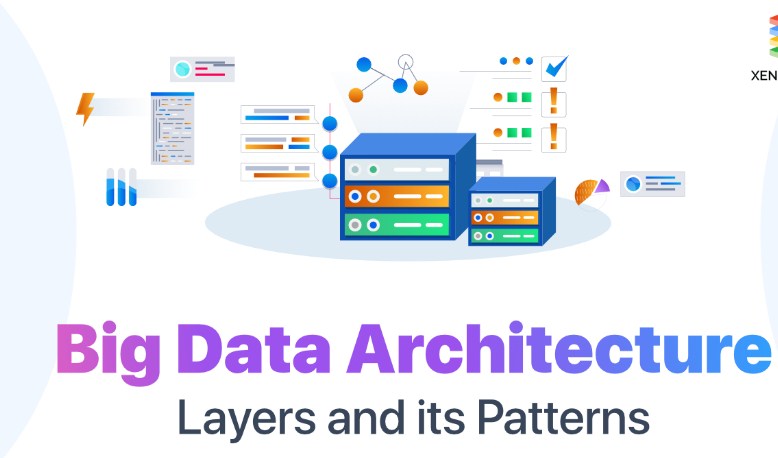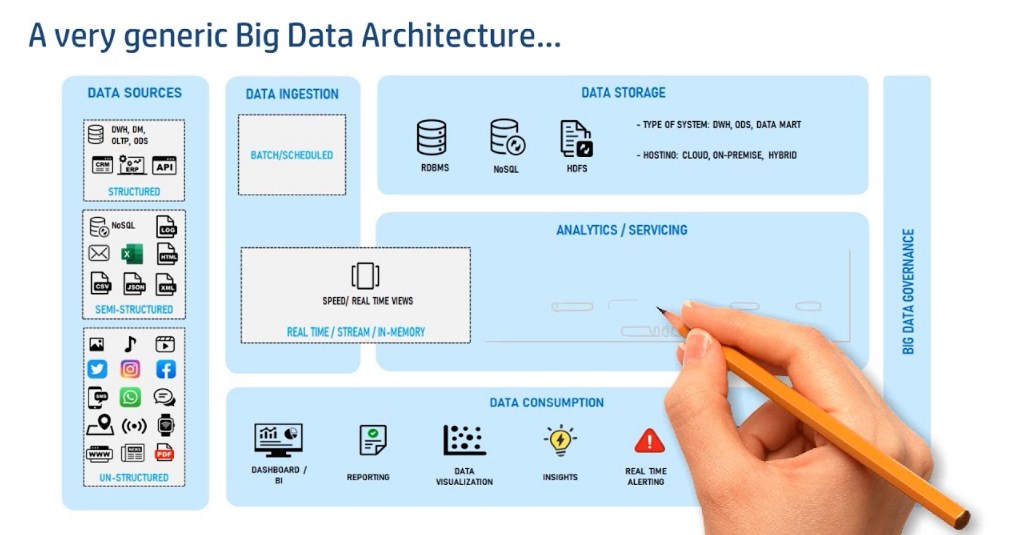Software Architecture for Big Data – In today’s tech-driven world, businesses are harnessing the power of big data and the cloud to drive decision-making, optimize operations, and stay competitive. But to manage such vast amounts of data efficiently and ensure scalability, a robust software architecture for big data and the cloud is essential. In this article, we will explore the key components of this architecture, its benefits, and highlight some of the best products in the market. Whether you are a business owner, IT manager, or developer, this guide will help you make informed decisions on the best solutions for your needs.

What Is Software Architecture for Big Data and the Cloud?
Software architecture refers to the design and structure of a software system. For big data and cloud computing, it defines how various components of a system interact to handle the vast quantities of data generated, stored, and processed across distributed systems.
When we talk about big data architecture, we’re referring to the system designed to process and analyze massive data sets that traditional systems may not handle effectively. Cloud architecture, on the other hand, involves designing solutions that run on cloud platforms (like AWS, Google Cloud, Microsoft Azure) to ensure scalability, flexibility, and accessibility of the data.
Together, these architectures need to be robust, scalable, and capable of handling not only large data volumes but also different data types—structured, unstructured, and semi-structured.
Key Components of Software Architecture for Big Data and the Cloud
- Data Sources: Data can come from multiple sources, such as IoT devices, user-generated content, social media, databases, etc.
- Data Processing: Handling raw data and processing it into useful formats involves batch processing, real-time processing, or streaming analytics.
- Data Storage: Cloud platforms provide various storage options like relational databases, NoSQL databases, and data lakes.
- Data Analytics: This is where data scientists and AI/ML algorithms analyze the data to extract meaningful insights.
- Security: With big data, ensuring the integrity and confidentiality of data becomes a crucial aspect of the architecture.
Benefits of Software Architecture for Big Data and the Cloud 🏆
- Scalability: Cloud infrastructure allows organizations to scale their data processing and storage as their business grows. With elastic computing resources, businesses only pay for what they use.
- Cost-Efficiency: Using cloud-based solutions reduces the need for expensive on-premise hardware and maintenance costs.
- Faster Decision-Making: With quick access to real-time data, businesses can make informed decisions rapidly, giving them a competitive edge.
- Improved Collaboration: The cloud enables teams to access data and applications from anywhere, fostering better collaboration and productivity.
- Advanced Analytics: Cloud platforms support big data analytics, helping businesses derive insights from vast data sets through AI and machine learning.
Top 5 Products for Software Architecture in Big Data and the Cloud
Below, we will explore five top products that can help implement an efficient software architecture for big data and the cloud.

1. Amazon Web Services (AWS)
Amazon Web Services (AWS) is a comprehensive and widely used cloud platform offering a suite of tools for big data and cloud architecture. With services like AWS Lambda, Amazon S3, and Redshift, AWS enables businesses to manage and analyze data efficiently.
Use Case:
AWS is ideal for companies looking to build highly scalable applications with massive data storage and processing needs. It’s used by e-commerce giants, healthcare providers, and finance industries for data warehousing, big data analytics, and AI.
Pros:
- Massive scalability
- Excellent security features
- Comprehensive ecosystem (AI, machine learning, analytics)
Cons:
- Can be overwhelming due to a wide range of services
- Pricing model can be complex
Price:
AWS operates on a pay-as-you-go model, so pricing depends on your usage.
| Feature | AWS |
|---|---|
| Use Case | Scalable cloud computing |
| Pros | Flexible, Secure, Feature-rich |
| Cons | Price complexity |
| Price | Pay-as-you-go |
2. Microsoft Azure
Microsoft Azure is another powerful platform that provides a wide array of tools for cloud and big data solutions. Azure’s data services, such as Azure Data Factory, Azure Synapse Analytics, and Azure Databricks, make it a strong choice for big data architecture.
Use Case:
Azure is widely used for hybrid cloud deployments, where organizations require both on-premise and cloud-based solutions. It’s perfect for businesses looking to integrate data processing with their existing infrastructure.
Pros:
- Integration with Microsoft products
- Strong enterprise support
- Hybrid cloud capability
Cons:
- Steep learning curve for beginners
- Costs can increase with usage
Price:
Azure offers a pay-as-you-go model, but also provides enterprise-level contracts for businesses with large-scale needs.
| Feature | Azure |
|---|---|
| Use Case | Hybrid and enterprise solutions |
| Pros | Integration with Office, strong security |
| Cons | Complex pricing structure |
| Price | Pay-as-you-go |
3. Google Cloud Platform (GCP)
Google Cloud Platform (GCP) provides powerful big data tools like Google BigQuery, Google Cloud Storage, and TensorFlow for machine learning. GCP is known for its data analytics and AI capabilities, making it a strong contender in big data architecture.
Use Case:
GCP is highly favored by tech companies and startups for big data analysis and machine learning applications. It’s particularly suited for businesses that rely on deep learning and AI.
Pros:
- Superior machine learning capabilities
- Real-time analytics
- Strong integration with Google tools
Cons:
- Smaller service range compared to AWS and Azure
- Somewhat less mature in enterprise markets
Price:
Google Cloud also works on a pay-per-use model and provides free credits for new users.
| Feature | Google Cloud |
|---|---|
| Use Case | Machine learning, AI-driven solutions |
| Pros | Advanced analytics, AI integration |
| Cons | Smaller service catalog |
| Price | Pay-per-use |
4. Cloudera
Cloudera is a leading platform for big data management, offering solutions for data engineering, machine learning, and analytics on a single platform. It is designed for enterprises that need to manage large volumes of data efficiently.
Use Case:
Cloudera is ideal for industries like healthcare, telecommunications, and finance where secure and scalable data architectures are critical for real-time insights.
Pros:
- Comprehensive data management tools
- Strong data security
- Multi-cloud flexibility
Cons:
- Requires technical expertise to use effectively
- Pricing can be higher for small businesses
Price:
Cloudera offers customized pricing based on enterprise needs and scale.
| Feature | Cloudera |
|---|---|
| Use Case | Big data management, enterprise-level security |
| Pros | Strong data management and security |
| Cons | High price, steep learning curve |
| Price | Custom pricing |
5. IBM Cloud
IBM Cloud offers robust solutions for AI, data analytics, and hybrid cloud architecture. With tools like IBM Watson and IBM Cloud Pak for Data, it is widely used by large enterprises.
Use Case:
IBM Cloud is suitable for enterprises looking for hybrid solutions and deep integration with AI and data analytics. It excels in industries like healthcare, banking, and manufacturing.
Pros:
- Excellent AI and machine learning tools
- Strong enterprise support
- Flexible hybrid cloud solutions
Cons:
- Complexity in using multiple tools
- Can be expensive for small businesses
Price:
IBM Cloud uses a flexible pricing model, often based on usage and customization.
| Feature | IBM Cloud |
|---|---|
| Use Case | AI-driven data management |
| Pros | Strong AI tools, hybrid cloud support |
| Cons | Complexity in deployment |
| Price | Custom pricing |
How to Buy and Where to Buy
These platforms offer cloud-based solutions with easy sign-ups directly on their websites. Here’s how you can get started:
- Amazon Web Services: Start Here
- Microsoft Azure: Start Here
- Google Cloud: Start Here
- Cloudera: Start Here
- IBM Cloud: Start Here
Each platform provides trial versions or free credits, so you can test them out before making any commitment. For enterprise-level purchases, you can contact sales teams directly for tailored solutions.
5 FAQs About Software Architecture for Big Data and the Cloud
- What is the difference between big data architecture and cloud architecture?
- Big data architecture is focused on handling and analyzing large data sets, while cloud architecture enables scalable and flexible cloud-based services to process, store, and access data.
- Which cloud platform is best for big data?
- The best cloud platform depends on your needs. AWS, Azure, and GCP are all leaders in big data solutions, with each offering distinct advantages like machine learning capabilities, hybrid cloud support, and scalability.
- Can I use big data software architecture for small-scale projects?
- Yes, but it’s recommended to choose lightweight cloud platforms or services with scalable features to avoid overspending.
- How can I ensure my data is secure in the cloud?
- Leading cloud providers like AWS, Azure, and Google Cloud provide robust security features like encryption, access controls, and regular compliance audits to keep your data safe.
- What is the pricing structure of cloud platforms?
- Cloud platforms typically use a pay-per-use pricing model based on usage of compute power, storage, and other services. Most platforms also provide free credits for new users to try out their services.
Conclusion
Choosing the right software architecture for big data and the cloud can significantly improve your ability to process and analyze data. With options like AWS, Azure, GCP, Cloudera, and IBM Cloud, businesses can tailor solutions that best fit their needs. By understanding the benefits, features, and use cases of these products, you can make an informed decision and ensure your business stays competitive in a data-driven world.
Read More >>>
- Best CRM Programs for Sales | Top Solution
- PSA and RMM Meaning: Everything You Need to Know About These Essential IT Tools for MSPs